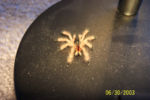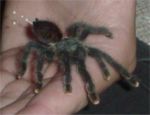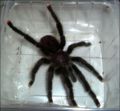Pinktoe tarantula
| Pinktoe tarantula |
|---|

|
| Scientific Classification |
|
| Pinktoe Species |
|
There are many different species of pinktoe tarantulas, with the most well known for this name being the type species of the genus (A. avicularia). Other also commonly referred to as pinktoe tarantulas include A. aurantiaca, A. braunshauseni, A. minatrix, A. versicolor.
The pinktoe tarantula was originally known as the "bird eating" spider. In fact the genus name "avicularia" means "small bird" in Latin. When Karl Von Linne (aka Carolus Linnaeus) was attempting to name virtually every animal on the Earth, this tarantula was the first identified. Birds, however, are not the only things pinktoes eat. [1]
Anatomy
The pinktoe tarantula has a bilateral symmetry. When the pinktoe is a baby, they have pink legs with black "toes." Once an adult, they are mostly dark with pink "toes." There is a little bit of a green color on the carapace and some reddish color on the opisthosoma.[2] The males are much smaller than the females. The females can be 4.5-5 inches in legspan.[3] The males can grow to be about 3.5 inches in legspan. [4]
Reproduction
The male has little hooks on his front two legs that he uses to grapple with the female's fangs. The male must carefully be released into the female's enclosure after she has made her sperm web. After breeding, the female should be fed a variety of food on a more frequent basis. The pinktoe tarantula is able to lay 50-200 eggs that can hatch within 6-8 weeks. Once the spiderlings are born they are able feed on crickets. [5]
Ecology
The pinktoe is a very docile and active creature. [6] They live in many common places but prefer to live in trees and other plants. They even coexist with mankind's expansion.[7] This particular species is very adaptable and makes a great pet.[8] You must be careful when handling a pinktoe, because if they are disturbed, they will shoot out some excrement.
Gallery
References
- Pinktoe Tarantula Avicularia avicularia by Eight.
- Pinktoe Tarantula (Avicularia avicularia) by Jon Fouskaris
- Pink-toed Tarantula Pink-toed Tree Spider by Russ Gurley. Animal World.
- Avicularia Wikipedia







